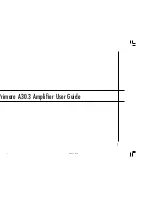
Philips Semiconductors
AN<nnnnn>
TDA1562Q application note
<12NC>
© Koninklijke Philips Electronics N.V. 2004. All rights reserved.
Application note
Rev. 01.02 — 05 May 2006
30 of 62
5.6 PCB lay out
To get the best possible performance from the TDA 1562Q a number of rules must be
observed during the lay-out of the PCB.
-
The copper tracks to the lift capacitors should be kept as short as possible, and the
surface of the loops enclosed by these tracks should be as small as possible, in
order to prevent radiation from these loops.
-
The signal ground and power ground tracks should be connected together at the
location where the power ground is connected to the PCB (Star grounding). It must
be prevented that high supply currents will run through signal ground or reference
ground tracks, since ripple on these tracks will cause unnecessary distortion.
-
The high frequency decoupling capacitor (100 nF) should be mounted as close as
possible to the supply pins.
-
Keep the tracks of the + and – inputs and the signal ground pin as close together as
possible, this way the surface of the loop which could pick up interference will be as
small as possible.
-
Because high currents will be running through the supply tracks and the output
tracks, it is advisable to make these tracks as wide as possible, and use PCB
material with a 70
µ
m copper layer.
The following figures show the PCB lay-out of the application PCB of the TDA 1562Q.
a. PCB components top view
b. PCB copper top view
Fig 15. Top view of the TDA1562Q PCB
















































